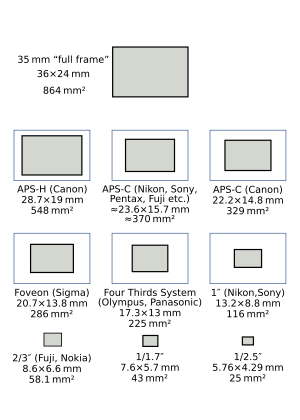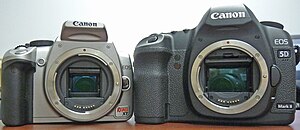Full-frame DSLR

A full-frame digital SLR is a digital single-lens reflex camera (DSLR) fitted with an image sensor that is the same size as a 35 mm (36×24 mm) film frame.[1][2] This is in contrast to cameras with smaller sensors, typically of a size equivalent to APS-C-size film, much smaller than a full 35 mm frame. Currently, the majority of digital cameras, both compact and SLR models, use a smaller-than-35 mm frame, as it is easier and cheaper to manufacture imaging sensors at a smaller size. Historically, the earliest digital SLR models, such as the Nikon NASA F4 or Kodak DCS 100, also used a smaller sensor.
Use of 35 mm film-camera lenses
If the lens mounts are compatible, many lenses, including manual-focus models, designed for 35 mm cameras can be mounted on the latest DSLR cameras. When a lens designed for a full-frame camera, whether film or digital, is mounted on a DSLR with a smaller sensor size, only the center of the lens's image circle is captured. The edges are cropped off, which is equivalent to zooming in on the center section of the imaging area. The ratio of the size of the full-frame 35 mm format to the size of the smaller format is known as the "crop factor" or "focal-length multiplier", and is typically in the range 1.3–2.0 for non-full-frame digital SLRs.
Advantages and disadvantages of full-frame digital SLRs

Full-frame DSLR cameras offer a number of advantages over their smaller-sensor counterparts. One advantage is that wide-angle lenses designed for full-frame 35 mm retain that same wide angle of view. On smaller-sensor DSLRs, wide-angle lenses have smaller angles of view equivalent to those of longer-focal-length lenses on 35 mm film cameras. For example, a 24 mm lens on a camera with a crop factor of 1.5 has a 62° diagonal angle of view, the same as that of a 36 mm lens on a 35 mm film camera. On a full-frame digital camera, the 24 mm lens has the same 84° angle of view as it would on a 35 mm film camera.
If the same lens is used on both full-frame and cropped formats, and the subject distance is adjusted to have the same field of view (i.e., the same framing of the subject) in each format, depth of field (DoF) is in inverse proportion to the format sizes, so for the same f-number, the full-frame format will have less DoF. Equivalently, for the same DoF, the full-frame format will require a larger f-number. This relationship is approximate and holds for moderate subject distances, breaking down as the distance with the smaller format approaches the hyperfocal distance, and as the magnification with the larger format approaches the macro range.
There are optical quality implications as well—not only because the image from the lens is effectively cropped—but because many lens designs are now optimized for sensors smaller than 36 mm × 24 mm.[citation needed] The rear element of any SLR lens must have clearance for the camera's reflex mirror to move up when the shutter is released; with a wide-angle lens, this requires a retrofocus design, which is generally of inferior optical quality.[3] Because a cropped-format sensor can have a smaller mirror, less clearance is needed, and some lenses, such as the EF-S lenses for the Canon APS-C sized bodies,[4] are designed with a shorter back-focus distance; however, they cannot be used on bodies with larger sensors.
In addition to wide-angle photography, another major advantage of full-frame cameras is pixel size. For a given number of pixels, the larger sensor allows for larger pixels or photosites that provide wider dynamic range and lower noise at high ISO levels.[5] As a consequence, full-frame DSLRs may produce better quality images in certain high contrast or low light situations.
The full-frame sensor can also be useful with wide-angle perspective control or tilt/shift lenses; in particular, the wider angle of view is often more suitable for architectural photography.
While full-frame DSLRs offer advantages for wide-angle photography, smaller-sensor DSLRs offer some advantages for telephoto photography because the smaller angle of view of small-sensor DSLRs enhances the telephoto effect of the lenses. For example, a 200 mm lens on a camera with a crop factor of 1.5 has the same angle of view as a 300 mm lens on a full-frame camera. The extra "reach", for a given number of pixels, can be helpful in specific areas of photography such as wildlife or sports.[6] This extra "reach" does come with the price of some loss of shutter speed, due to the aforementioned "crop factor". Teleconverters enable full-frame cameras to achieve a similar effect.
Production costs for a full-frame sensor can exceed twenty times the costs for an APS-C sensor.[citation needed] Only 20 full-frame sensors will fit on an 8-inch (200 mm) silicon wafer, and yield is comparatively low because the sensor's large area makes it very vulnerable to contaminants—20 evenly distributed defects could theoretically ruin an entire wafer. Additionally, the full-frame sensor requires three separate exposures during the photolithography stage, tripling the number of masks and exposure processes.[7]
Some full-frame DSLRs intended mainly for professional use include more features than typical consumer-grade DSLRs, so some of their larger dimensions and increased mass result from more rugged construction and additional features as opposed to this being an inherent consequence of the full-frame sensor.
Other uses of full-frame
CCD image sensor architectures
The term full-frame is also used to refer to a type of charge-coupled device sensor technology in which the sensor elements occupy the entire sensor surface rather than sharing space with associated pixel storage sites.[8][9]
The use of full-frame CCDs is typically restricted to digital SLRs since they require the use of a mechanical shutter and do not output a continuous image. The two uses of the term full-frame are not otherwise related.
135 film cameras
In 35 mm (135 film) cameras, the terms full-frame and half-frame were used to distinguish the 24 × 36 mm and 18 × 24 mm film formats;[10] the half-frame 35 mm film format is also known as single-frame in movie film, and as a result, full-frame film cameras were sometimes known as double-frame.[11]
Past and present full-frame digital cameras
DSLRs

- Contax N Digital (2002)
- Canon EOS-1Ds (2002)
- Kodak DCS Pro 14n (2003)
- Kodak DCS Pro SLR/n (2004)
- Kodak DCS Pro SLR/c (2004)
- Canon EOS-1Ds Mark II (2004)
- Canon EOS 5D (2005)
- Nikon D3 (2007)
- Canon EOS-1Ds Mark III (2007)
- Nikon D700 (2008)
- Sony α DSLR-A900 (2008)
- Canon EOS 5D Mark II (2008)
- Nikon D3X (2008)[12]
- Sony α DSLR-A850 (2009)[13]
- Nikon D3S (2009)[14]
- Canon EOS-1D X (announced in 2011, released in June 2012)[15]
- Nikon D4 (2012)[16]
- Nikon D800 (2012)[17]
- Canon EOS 5D Mark III (2012)
The Nikon E2/E2s (1994),[18] E2N/E2Ns (1996)[19] and E3/E3s (1998)[20] digital SLRs as well as the similar Fujifilm Fujix DS-505/DS-515, DS-505A/DS-515A and DS-560/DS-565 models used a reduction optical system (ROS) to compress a full-frame 35 mm field onto a smaller 2/3-inch (11 mm diagonal) CCD imager. They were therefore not digital SLRs with full-frame sensors, however had an angle of view equivalent to full-frame digital SLRs for a given lens; they had no crop factor with respect to angle of view, but did have a factor that changed the f-number of the lens by more than a factor of 2.[21]
Nikon has designated its full frame cameras as FX format and its smaller sensor cameras as the DX format.
Rangefinders
- Leica M9[22] (2009)
- Leica M9-P[23] (2011)
- Leica M Monochrom (2012)[24]
Prototype full-frame digital SLRs
- Pentax MZ-D "MR-52" (presented in 2000, based on Pentax MZ-S, with the same sensor as Contax N, it never went into production)[25]
- Sony Alpha flagship model "CX62500" (presented at PMA 2007, early prototype of what one-and-a-half years later became the DSLR-A900 (aka "CX85100"), though with many detail differences)[26][27]
See also
References
- ^ Nigel Atherton, Steve Crabb, Tim Shelbourne (2006). An Illustrated A to Z of Digital Photography: People And Portraits. Sterling Publishing Co. Inc. ISBN 2-88479-087-X.
{{cite book}}: CS1 maint: multiple names: authors list (link) - ^ Ross Hoddinott (2006). Digital Macro Photography. Sterling Publishing Co. Inc. ISBN 1-86108-452-8.
- ^ "Retrofocus Design Problems: A Synopsis". Camerarepair.com. Retrieved 2010-12-30.
- ^ "The Canon Camera Story: 2001-2004". 2004-11. Retrieved 2009-09-26.
{{cite web}}: Check date values in:|date=(help) - ^ "Full-frame sensors". Photocrati. Retrieved 2010-12-30.
- ^ Barbara Gerlach (2007). Digital Nature Photography: The Art and the Science. Focal Press. p. 67. ISBN 978-0-240-80856-7.
- ^ "Canon's Full-Frame CMOS Sensors: The Finest Tools for Digital Photography" (PDF) (Press release). Canon. 2006. Archived from the original (PDF) on 2010-10-10. Retrieved 2009-12-26.
- ^ Albert J. P. Theuwissen (1995). Solid-State Imaging with Charge-Coupled Devices. Springer. ISBN 0-7923-3456-6.
- ^ Patrick Martínez and Alain Klotz (1998). A Practical Guide to CCD Astronomy. Cambridge University Press. ISBN 0-521-59063-9.
- ^ Frances E. Schultz and Roger Hicks (2003). Rangefinder: Equipment, History, Techniques. Sterling Publishing Co. Inc. ISBN 1-86108-330-0.
- ^ Leslie D. Stroebel and Richard D. Zakia, editors (1996). Focal Encyclopedia of Photography. Focal Press. ISBN 0-240-51417-3.
{{cite book}}:|author=has generic name (help) - ^ Posted on November 30, 2008 11:00 PM (2008-11-30). "Nikon D3x press announcement as of November 30th, 2008". Press.nikonusa.com. Retrieved 2010-12-30.
{{cite web}}: CS1 maint: numeric names: authors list (link) - ^ "Sony Alpha DSLR-A850 press announcement as of August 27th, 2009". News.sel.sony.com. 2009-08-27. Retrieved 2010-12-30.
- ^ Posted on October 14, 2009 12:00 AM (2009-10-14). "Nikon D3s press announcement as of October 14th, 2009". Press.nikonusa.com. Retrieved 2010-12-30.
{{cite web}}: CS1 maint: numeric names: authors list (link) - ^ "Canon U.S.A. Introduces The New Canon EOS-1D X Digital SLR Camera, Re-Designed From The Inside Out" (Press release). Canon U.S.A. October 18, 2011. Retrieved October 18, 2011.
- ^ "When There Is No Second Chance: The New Nikon FX-Format D4 Multi-Media Digital SLR is The Definitive Unification Of Speed And Precision" (Press release). Nikon Inc. January 5, 2012. Retrieved January 6, 2012.
- ^ "Expectations Surpassed: The 36.3-Megapixel Nikon D800 Is The Multimedia HD-SLR That Shatters Conventional Resolution Barriers For Maximum Fidelity" (Press release). Nikon Inc. February 6, 2012. Retrieved February 7, 2012.
- ^ "Technical information on Nikon E2/E2s and Fujifilm Fujix DS-505/DS-515 at MIR - Photography in Malaysia". Mir.com.my. Retrieved 2010-12-30.
- ^ "Technical information on Nikon E2N/E2Ns and Fujifilm Fujix DS-505A/DS-515A at MIR - Photography in Malaysia". Mir.com.my. Retrieved 2010-12-30.
- ^ "Technical information on Nikon E3/E3s and Fujifilm Fujix DS-560/DS-565 at MIR - Photography in Malaysia". Mir.com.my. Retrieved 2010-12-30.
- ^ Jarle Aasland, Nikon E2N, NikonWeb.com.
- ^ Leica M9, Leica Camera AG
- ^ Leica M9, Leica Camera AG
- ^ "Leica announces M-Monochrom black-and-white 18MP rangefinder". Digital Photography Review. May 10, 2012. Retrieved June 17, 2012.
{{cite web}}: Italic or bold markup not allowed in:|publisher=(help) - ^ Asahi Optical Historical Club (2001) "MR-52" 6 Megapixel digital SLR]
- ^ – Charlie White (2007-03-08). "Charlie White's Gizmodo PMA March 8th, 2007 report on Sony press announcement in regard to Sony Alpha flagship model "CX62500"". Gizmodo.com. Retrieved 2010-12-30.
{{cite web}}: CS1 maint: multiple names: authors list (link) - ^ Matthias Paul, Sony Alpha CX model codes overview Forum article in German Minolta-Forum as of September 30th, 2009
